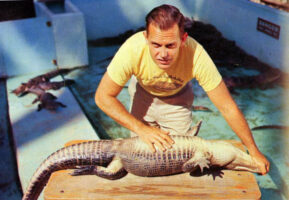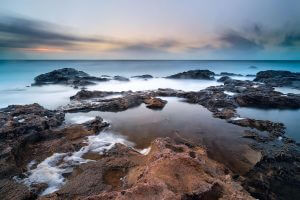Support Hidden Compass
Our articles are crafted by humans (not generative AI). Support Team Human with a contribution!
A chain-link fence, topped in barbed wire, guards a collection of crumbling adobe buildings. Scrawled graffiti warns “DANGER” through splintered wooden beams. On the other wall, “home” and “daddy” can be made out — the spray paint faded.
I cannot step any closer to read the graffiti in its entirety. Cowboy boots cover my ankles and protect against snake bites, but the brambles and burs collected in the dry ditch between the unpaved road and the base of the fence, roughly six feet away, prove treacherous.
No car has passed since my travel companion, Vic, and I pulled over at this forgotten site in Arizona. Driven by a never-waning desire to seek the less seen, we had followed roads that looked like pencil sketches on the map. On this day, my journey here is not yet personal.
A few miles before we arrived, where the sparkling lights of Mexico can be seen through the haze, a Border Patrol agent had waded through waist-high grasses with binoculars pointed toward the U.S.-Mexico border wall — territory formerly battled over during the Mexican Revolution.
There are no lights behind this barbed wire fence, just hollow adobe facades and a series of signs that do little to beckon the reader closer.
On one of those unreachable signs, I read:
“The city of Bisbee is proud to be the steward of Camp Naco.
It is truly an historic treasure to be preserved and developed to
remind all of us of the rich history we enjoy in our borderlands of
the United States and Mexico.
“Please treat it with the respect it deserves.”
~~
The empty adobe buildings in front of me are home to nothing more than the dry grass that has begun to wear away at their foundation, their delicate mud facades, and the graffiti that litters them. Through the chain-link fence, I can discern the ruin of a horse stable across the plot. In audible contrast to the tourism and pageantry I have witnessed at other military sites in Arizona, only a bird chirps and flits from branches that have grown through the remaining roof slats.
In this moment of seemingly palpable desert silence, however, I allow myself to pretend that horses are pawing the ground in front of me and soldiers are aligning in formation — their boots scuttering across the clay, uniforms neatly buttoned, horses awaiting orders.
These men are anonymous to me, the details of their narratives still unknown. Another sign, farther down the fence line, declares them “Buffalo Soldiers” — the Black soldiers who fought in the Mexican Revolution, skilled horsemen in pursuit of the American dream. The Black soldiers who had seen the end of slavery.
With the chain-link pressed between the folds of my fingers, I’m on the outside looking in, searching what remains of the rest of their story.
Though this is the first time I have gazed upon Camp Naco, the situation resonates familiarly.
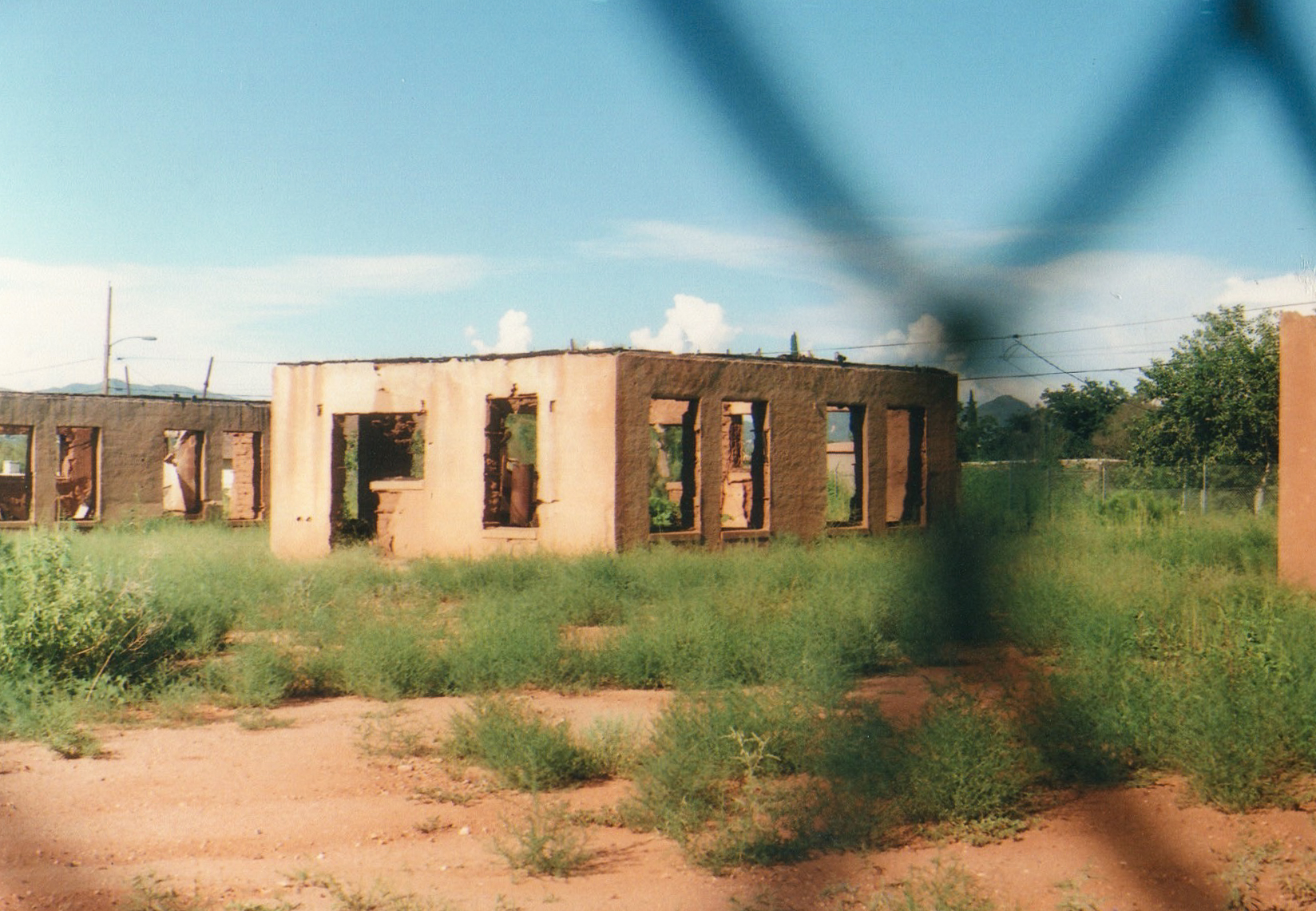
A chain-link barrier informed the author’s vantage on her first visit to Camp Naco, a former military outpost in Arizona near the border with Mexico. Photo: Lauren Napier.
~~
The Buffalo Soldiers have long been a softly spoken piece of America’s military history and its expansion westward. Having proven themselves proficient fighters during the Civil War, Black men in the Southwest found themselves protecting their new home as soldiers, on the frontlines as freedmen during the Mexican Border War.
Six Black regiments were formed in 1866, including the Ninth and Tenth Cavalry Regiments. Upon the western frontier, the shadow of the South must have seemed distant. Soon, the soldiers would be hunting Pancho Villa, starring in Buffalo Bill’s Wild West Show, and even helping to establish the country’s national parks.
The buildings that stand before me represent the remains of the 23 adobe buildings, out of an original design of 35, that housed the Tenth Cavalry. Construction began in 1919. Four barracks, housing more than a hundred soldiers, stood encircled by additional buildings — a hospital, officers’ quarters, noncommissioned officers’ buildings, bathhouses, mess halls, and horse stables.
Just more than a century later, tumbleweeds litter the cordoned-off plot. The shuffle of boots went quiet long ago, replaced by the chatter of animals and insects. Lurking somewhere in this dry, bristling brush are tiny birds — their presence unseen but vocal, like their human predecessors.
~~
Long before Camp Naco’s wood splintered and decayed, Charles Young would have ridden his horse down the now-worn paths in front of me and tied his horse to a hitching post. His name is not one I had heard before, but that isn’t due to his lack of historical impact:
Third African American to graduate from West Point. First African American National Park Superintendent. First U.S. military attaché on the island of Hispaniola (Haiti and the Dominican Republic). And, in 1916, the first African American to formally command the Second Squadron in the Tenth Calvary at Camp Naco.
It is an impressive testimonial. If Young were any other soldier, surely his service at Camp Naco would be commemorated. But he was a Buffalo Soldier. His legacy faces the same uphill battle that his career did.
But I don’t know this yet. Young greets me later on in my own journey, after my curiosity leads me from the dunes of the desert to the pages of historical texts. That’s where he’s waiting for me.
~~
Treat it with the respect it deserves.
Ghostly vestiges appear in my mind’s eye: young men leaning over their desks, the wood of the military furniture faded in the Arizona sun and matching the muted dust of the outside terrain. Sweat beads upon their brows as the men study the written word.
In desperation tinged with a desire to be accepted and escape the stigma of illiteracy that had been mandated on their enslaved forebears, Buffalo Soldiers find themselves in yet another strange land. They are free but still shackled by a lack of choice.
In one text, aptly titled “Their Life’s Blood: The Tenth Cavalry in Arizona, 1914–1921,” historian David Work wrote: “… Black Americans served their country with pride, which was reflected in low desertion and high re-enlistment rates. From 1910 to 1917, the Tenth Calvary was one of two regiments with the lowest desertion rate in the U.S. Army. Moreover, its troopers frequently re-enlisted.”
I cannot help but view those surprisingly low rates through a broader lens: To what would those Black soldiers have been deserting?
For Young, a military life was nearly inescapable. When he was less than a year old, his family escaped from slavery. His father soon enlisted in the 5th Regiment, U.S. Colored Heavy Artillery. When Young reached the age to make a decision among the limited possibilities afforded to a young Black man in this time and place, the soldier’s life resounded clearly as the only acceptable option. Sharecropping would have tied him to the land, a future not far from his own parents’ past.
With a guaranteed change of clothes, promised shelter and education, and $13 a month, military service was an opportunity from which a young Black man dare not turn away.
The Army offered these soldiers a chance at social betterment and a way, perhaps naively believed, to join a world that had previously turned its back. But if there is a lack of choice, is it truly freedom to choose?
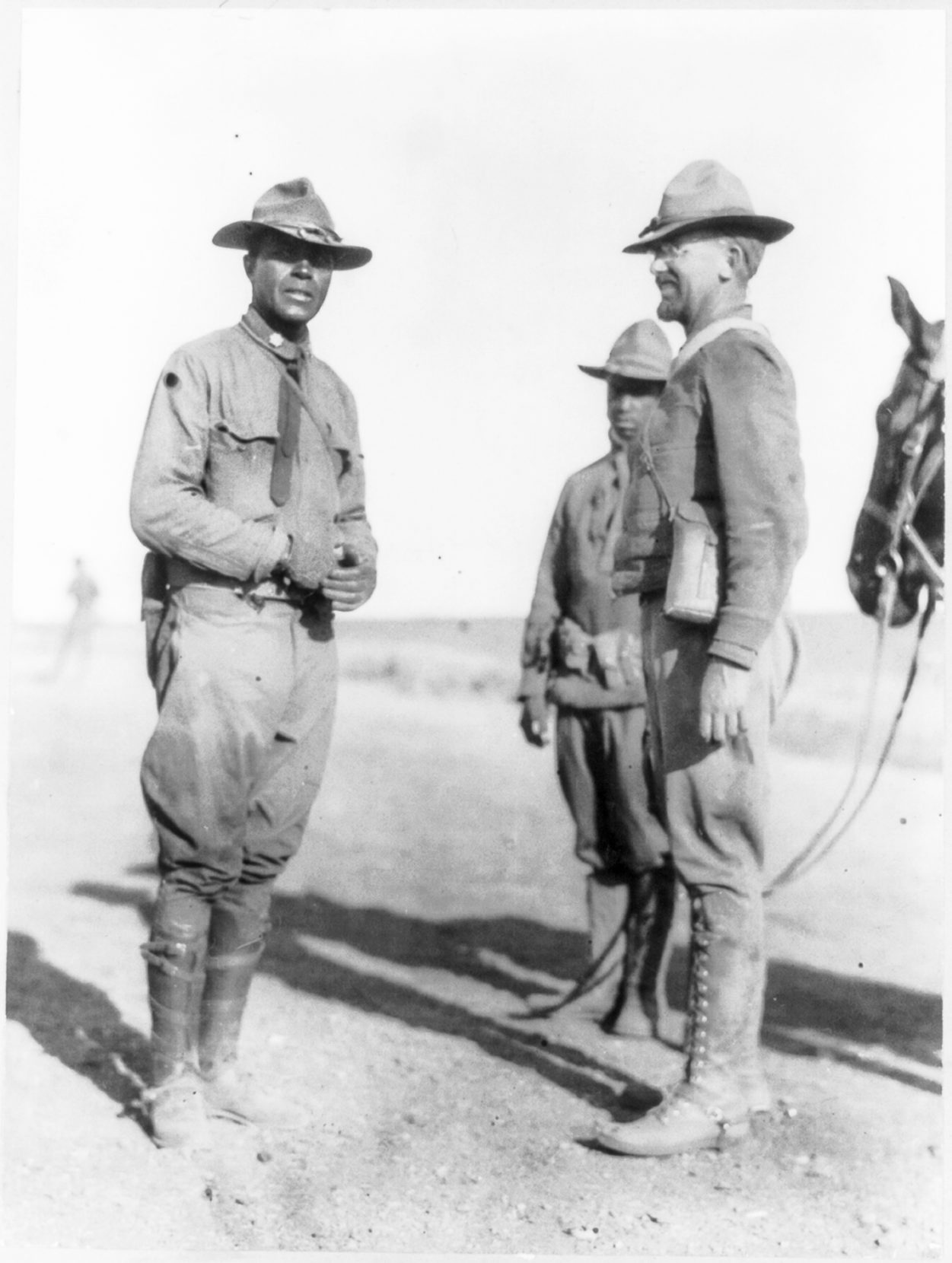
Major Charles Young (left) and Captain John R. Barber during the Mexican Revolution. Photo: Underwood & Underwood/Library of Congress.
~~
I look out over the red soil and feel the formidable Arizona sun baking my skin. In the camp’s early years, before the construction of the adobe buildings, humans often outnumbered the available housing options here, making it a common occurrence for soldiers to spend months in a tent.
That was the expectation at Camp Naco, created as a temporary outpost for nearby Fort Huachuca. Men were rotated out of one camp and sent to occupy another. Naco was where the men sweat in the desert heat before returning to the comfort of the Huachuca Mountain altitude.
Amid this hostile environment, racial tensions simmered. As Black members of the regiments were tasked with grueling work and hand-me-down horses, they “complained their white counter parts did nothing,” Work wrote.
I imagine both horses and humans working twice as hard under a sun much hotter than what their bodies were used to, with no physical respite. As they toiled, all they must have held onto was hope that their country would serve them upon their return.
In the evening, Young would sit at the piano or play his banjo. He spent a lot of time with his horse, tending to find solace among animals.
I have learned about Young’s life through his achievements; surviving letters home to his wife, Ada; and, often, through what is not said about him. Through his quiet presence.
Lurking somewhere in this dry, bristling brush are tiny birds — their presence unseen but vocal, like their human predecessors.
Getting to know someone through the words left unsaid comes naturally to me.
~~
Immersed in a desert expanse, I can hear slave calls ripple across the open landscape, duetting with the swirling dust. To the white men in charge, these melodies skim superficially across the sand. To the Black soldiers who serve as their charges, the songs forge a bond, conveying a deeper meaning of resilience.
A walkie-talkie clicks and a voice calls my father back to base.
On calls home to me and my mother, gusts of wind and bombs dropping in the distance provided the backing track for my dad’s calm and cold voice, mechanically filtered through the phone.
Nearly a century after Camp Naco’s heyday, my father’s physical landscape resembled that of the Tenth Cavalry: Afghanistan, Kyrgyzstan, Oklahoma. Unfortunately, his personal terrain also mirrored that of the Tenth Calvary: The bias was as much a part of the landscape as the dust storms.
Under a facade of integration, racial tensions ran deep in his troop, disguised and left to fester as military aggression.
My father had long kept his three-plus decades of military service largely a secret from me. Now he tells me there were some things he didn’t want me to know. A silence has existed between us, a bridge not traversed by the softening of time. Entrenched in a search for the roots of my family tree and for hidden pieces of history, I have started calling him to talk family, history, truth.
During these conversations, both in person and on the telephone, he tells me how the ugliness he faced was not isolated to the battlefield.
“We had to live in our own little world,” affirms my mother as the two of us sit, reflecting, in the living room. “The outside was so ugly.”
My father tells me about having to keep his suit extra crisp for fear of being chastised by a commanding officer. Of taking care of flag duty while the white soldier officially assigned to the task took an unapproved nap.
Sometimes, white men would be transferred into my father’s troop from units that might not have had room for upward mobility.
“They’d change their MOS [military occupational specialty] to mine, and then get that promotion,” he says.
Other truths were revealed earlier on. In middle school I learned that the bald spot on my cat’s head was from soldiers putting out cigarette butts on his head; and that the children at my Tennessee elementary school were not asking about the flavors of birthday cupcakes when they asked why one was black and one was white, but of my parents’ color.
My parents’ innocent erasure — to prolong the bliss of childhood’s rose-colored glasses — is sadly akin to the effacement of Black soldiers from history, though the intent was different.
The effect reverberates beyond crumbling adobe buildings.
~~
Young was also a soldier often overlooked, passed over for promotion even when his rank surpassed the chosen leader. In his letters home to Ada, he is calm and careful and cautious, assured that he will advance when his superiors see fit. Years passed in patient self-advocacy. W.E.B. Du Bois beseeched the military on Young’s behalf, as President Wilson found ways to disperse Black soldiers throughout America without the inevitable “tragic insubordination” that would result if white enlisted men were to be under the charge of Black officers.
At the same time, Charles Young was sending money home regularly to Ada for the Anti-Lynching Fund, writing, “It will help not a little to swell the fund of $10,000 they are raising toward the end of breaking up that blamed shame to the country.”
Young was physically fighting against the rebels invading the newly claimed Southwestern American border and financially fighting for his newly obtained American freedoms.
But his resolve was not the only thing in those letters that stopped me in my tracks.
Upon his arrival at Fort Huachuca, Young wrote: “Cabell told me how glad he was that I was here, and how much I could help him in the regiment by getting in touch where he could not.”
He is referring to Lt. Col. De Rosey C. Cabell.
Cabell is the surname of the family that once owned my family.
~~
Away from the Arizona heat, the property list of a Virginia plantation sprawls across my desk as I search for my ancestors’ names in a roll of slaves. Nearly illegible writing confirms that my fourth-great-grandmother was owned by the Massie family at Pharsalia, a large slave-breeding farm in Virginia.
Though a couple generations removed, my father is a soldier descended from slaves.
Access to these names has been difficult to claim; after I tracked down the “William Massie Slave Account Book, 1836-1866,” the Library of Virginia required a not-so-modest sum to obtain photocopies for my personal use. The irony of paying for a document that holds my enslaved ancestors’ names — to a library that was originally housed in a building erected with enslaved labor — is not lost on me.
It underscores the necessity to share the truths uncovered.
Early in my search for Buffalo Soldier records, I arrived at a tragic roadblock: A 1973 fire at the National Archives in St. Louis had destroyed millions of military personnel files, including many of those of the 10th Cavalry.
It’s strangely fitting that these men who are not often spoken of had been physically erased from the record shelves.
~~
In the fall, Vic and I find ourselves in Nelson County, Virginia, pointed toward the slave cemetery — supposedly a short drive down the pavement and a quick right turn onto a dirt road.
A search for relatives brings me here.
We arrive at a fence marked “Private Property.” Behind it spreads an expanse of vast fields with cotton blossoms floating in the autumn breeze. Across the street, in front of a well-manicured home with red shutters, a plaque celebrates its name and origin: Rock Cliff, 1854.
Now I know that this stately home remains within the Cabell family, their own ancestors buried at the well-documented Liberty Hall cemetery. Remains left to visit for searching relatives, their questions answered in the here and now: not to be pieced together by the tangential tidbits of a stranger’s diaries.
I step out of the van and walk along the pavement, which seems particularly dark against the golden fields, dry and shining in their autumn hues. The van door slams sharply in the hush of this place.
Pavement covers the trodden soil where my fourth-great-grandmother, Sukey, would have walked in fetters. I notice a barn crumbling into the mouth of a cave and feel an unexplained pull to explore. I stop. A “No Trespassing” sign means a bit more in this part of the world than it might in some places.
With the chain-link pressed between the folds of my fingers, I’m on the outside looking in, searching what remains …
Later, my father shares a bit of Nelson County lore: A series of caves underneath that weathered wood structure were said to have been used by slaves. Now, it, too, sits behind a fence, where their bodies and histories remain private property, and the ground has collapsed in upon itself.
But the name that remains on the street sign declares its presence for all who drive by: Cabell Road.
~~
The summer of 1920 saw no end to the soldiers’ turmoil in Arizona. After the Mexican Revolution was over, and the U.S. border secure, the Calvary remained at Camp Naco. In theory, these Black soldiers lived as freedmen. But they did not possess the freedom of mobility or to choose where to start their American dream.
Even after faithful service to their country, Buffalo Soldiers’ pensions were not assured. That had been made clear in 1906 with President Theodore Roosevelt’s dishonorable discharge of 167 Buffalo Soldiers in Texas, following a shooting of a white man in Brownsville that locals alleged was the fault of Black soldiers — even though every last soldier had been accounted for in their barracks.
The outpost of Naco was far removed from the larger surrounding towns, towns that were not welcoming of new Black community members. And so the soldiers stayed at Camp Naco, out of sight and out of mind.
Young’s story has echoes of the same fate. In addition to being forced into medical retirement, albeit briefly, he was sent on a series of fool’s errands, including an appointment in Ohio where the troops he trained were “understood to be a regiment raised purely for political purposes … and is not required for service anywhere,” as explained in a War Department memo.
In 1922, he died far from the Arizona desert at his final post in Liberia, answering the political calls of his ancestral lands.
In 1923, Camp Naco was closed, its military ranks disbanded.
~~
The tires grind on the wet gravel road. The scent of rain is on the breeze and blades of grass are upturned, expectant. The hills are lush, yellow butterflies flit in the sky, and birds chirp as they dive after mosquitoes in the humid air.
On this, my second visit to Camp Naco, a friendly face awaits to unlock the gate and to welcome me behind the fence. The dampened adobe facades stand in vibrant contrast to the green hues of the desert. With a nearly verdant landscape and a smiling host, this place greets me with a warmth I hadn’t encountered six months earlier.
Wriggling through the cracks in the mud, devil’s claw blooms around the gate, the ends curve skyward. Later, some locals tell me it had been the wettest year on record in this part of Arizona.
“Any friend of the camp is a happy camper,” says my guide, David, who awaited me at the gate. David is an unofficial guardian of the camp, and I consider myself lucky to have him as a narrator of this tour. He hands me the opened lock. His burro is baying around the corner: Dinner takes precedence.
I stop a moment to feel the desert air against my cheeks, to glimpse the cracked mud beneath my feet. Vic steps on ahead, the plodding of his boots creating a percussive drone to ground the musings in my head. I duck through branches and a dilapidated doorway.
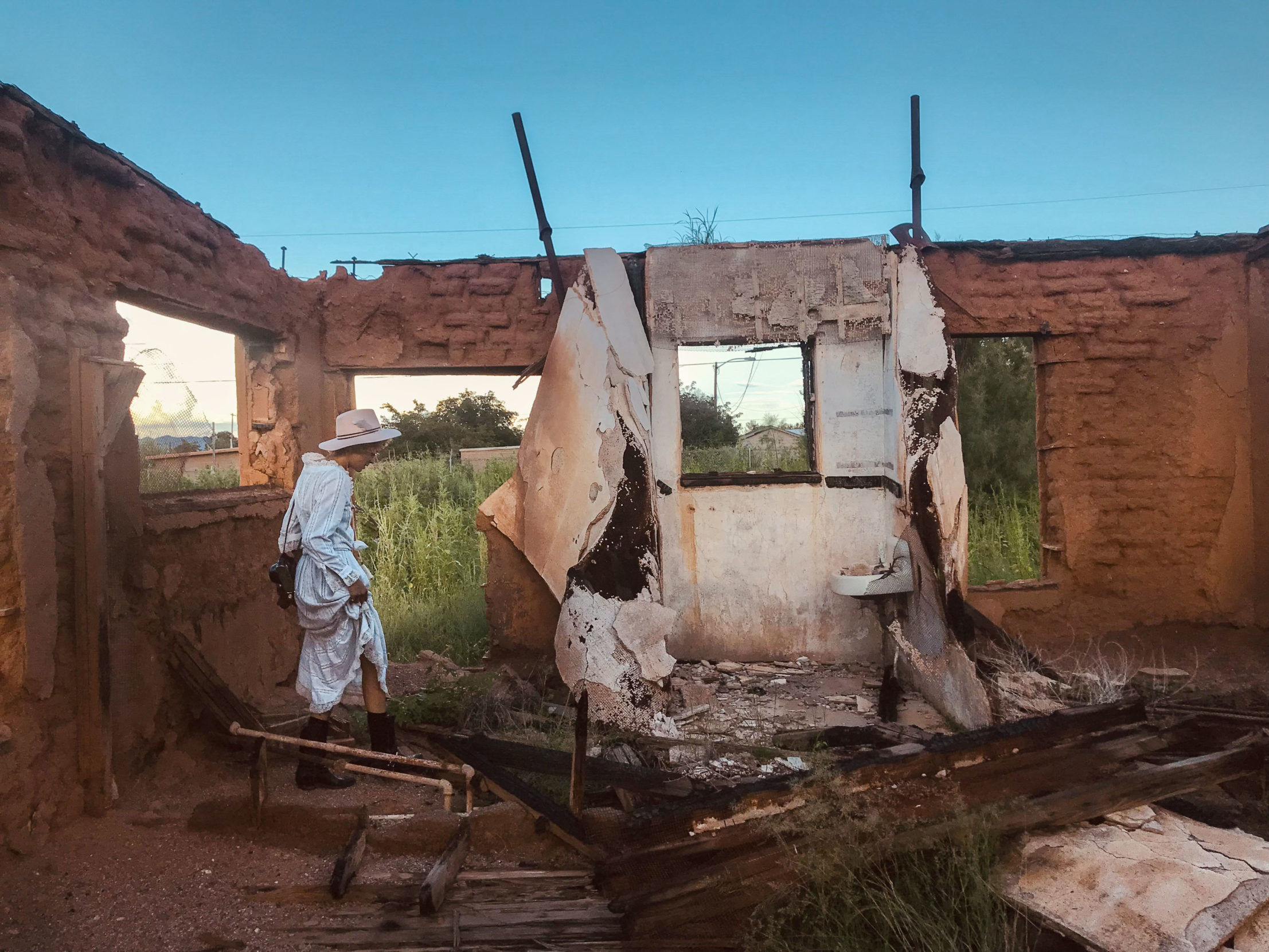
On the author’s return visit to Camp Naco, after gaining access to the site, she steps directly upon the ruins. Photo: Lauren Napier.
Weeds and no-see-ums dance around my legs, welts already forming on my flesh.
My boots lead me from one corner of the lot to another.
I pause and look through an open window of a roofless office: the tilted metal frame a victim of arson and, subsequently, abandoned as worthless scrap material.
Through it I can see the water tower and nothing else. If I ignore the peripheral knowledge that the nearby town of Naco is now nearly a thousand people, I can find myself alongside Charles Young.
I can’t help but think of one of his many letters home to his wife, in which he casually mentions a visitor — “a friend of our Willett Family.”
His hand assuredly steady, tone unfaltering, had used a possessive pronoun — our Willett family — to talk about the family who had owned his mother and father. The man from whom his mother and father escaped.
His still cautious tongue echoed off the page. Friend or foe? Freedom, or slavery of a different shackle?
~~
On my first visit to Camp Naco, as I traced the fence line, a tear slipped down my cheek as I absorbed the weight of the abandonment, both past and present. Now, as I tread directly upon Camp Naco soil, goosebumps spread across my skin.
Just underneath that topsoil is a story of nuance, of honor, of resolve. A story asking to be told. Where Young hosts a friend of the family who owned his parents, where white men led freed slaves-turned-soldiers, where the new dream of the American West began and an old narrative remained.
The sun begins to set and the mosquitoes get more plentiful, forming buzzing clouds. Vic and I show ourselves outside of the gate. I take a moment to say thank you to the space, put the lock back, and adjust the No Trespassing sign.
A surprising detail that had emerged from my conversation with David was the pronunciation of Naco: a soft a replaces the aggressive vowel I had been using.
David chuckles as I comment on my error. This was the first time someone had spoken the name of the camp to me, its pronunciation lost in the reading of books and relying on text sources.
Not only can I pronounce Naco correctly, I now have a story to tell to a listening ear. This camp’s story, like my family’s, shall not be lost within the landscape.
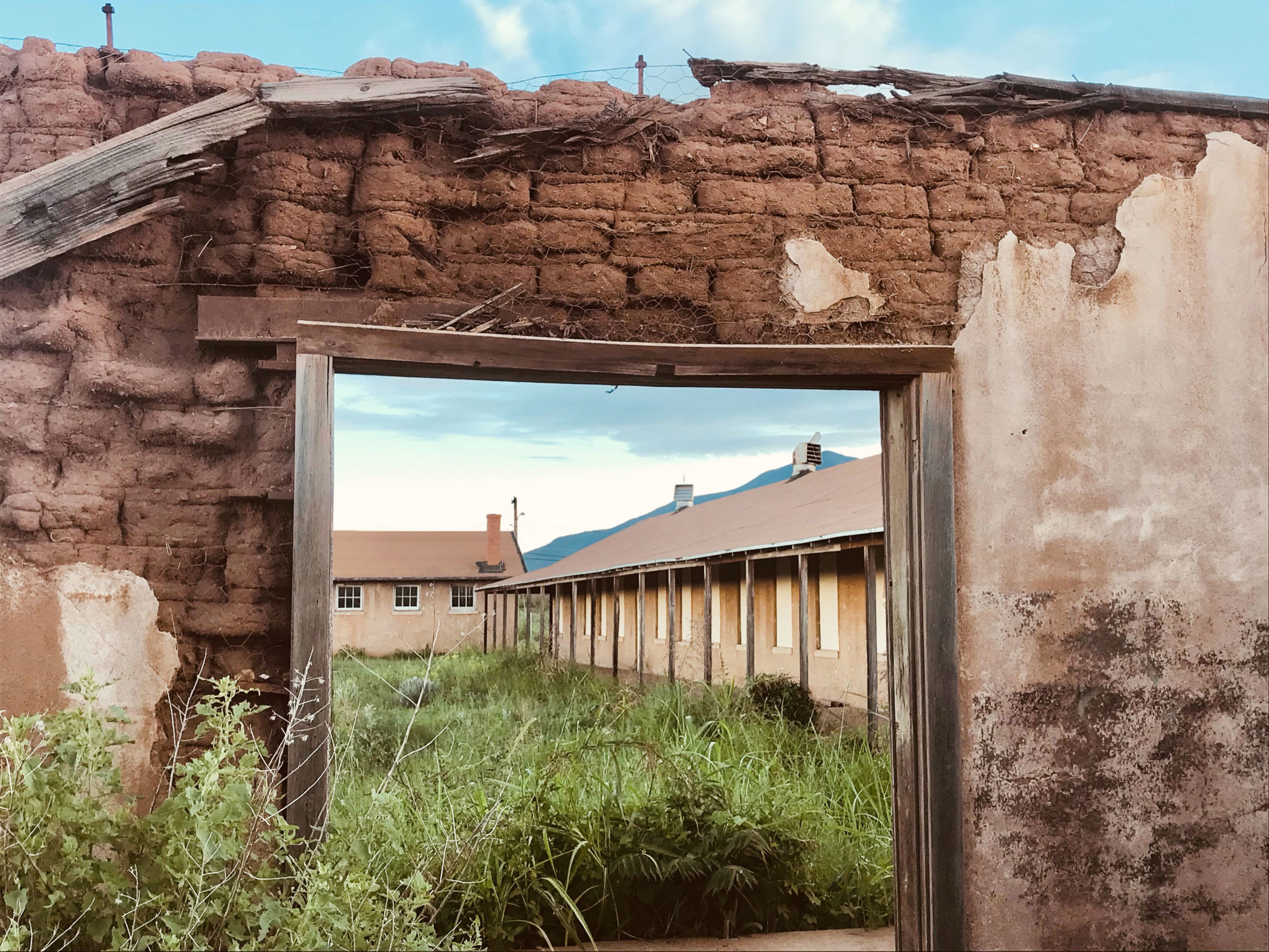
Construction of Camp Naco’s buildings began in 1919. Among the only Western camps made of adobe, the outpost has deteriorated in the face of vandalism, arson, and erosion. Photo: Lauren Napier.
Lauren Napier
Lauren Napier finds solace in melody and the written word. She has penned a children’s book, All My Animals, and stories for NPR Berlin, amongst other texts and songs.

